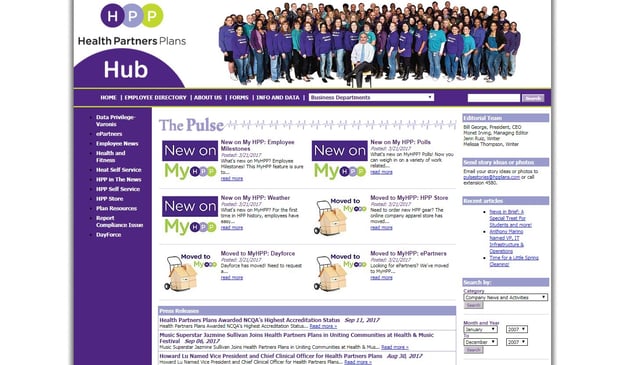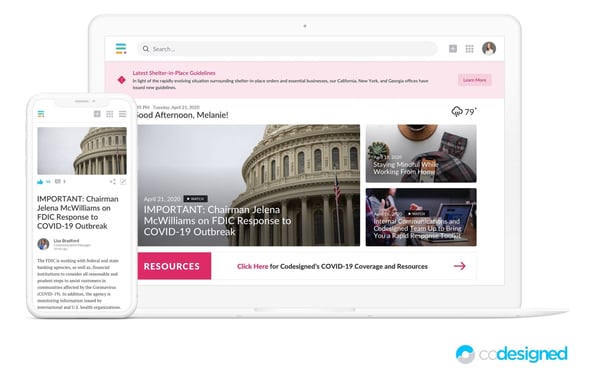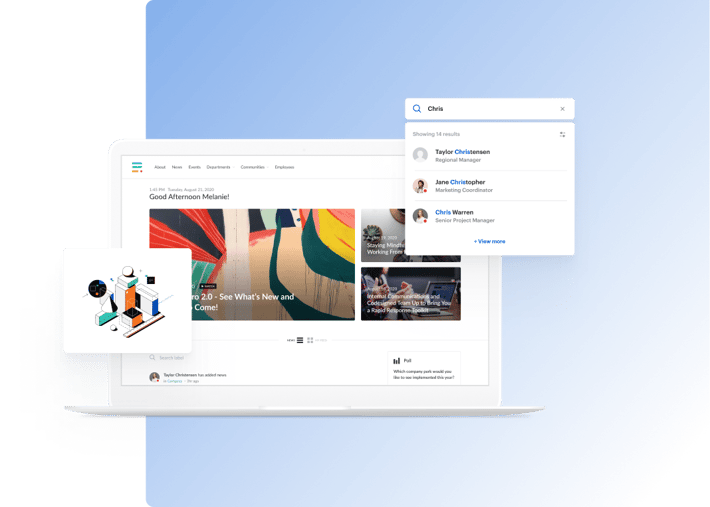Your Intranet Needs a Reboot Now More Than Ever

A decade ago, remote working was rare. Many organizations believed that remote workers were harder to manage, less effective, and too easily distracted whilst working from home. In recent years, this perception has changed. As communication and teleconferencing technology has improved, the number of remote workers has greatly increased – a trend that was significantly impacted by the COVID-19 outbreak.
The pandemic forced organizations around the world to act fast to enable their workforces to work remotely. No one knows what the future will bring or whether things will ever return to how they were, but one thing is for certain: clear and concise internal communications is a vital part of successful crisis and change management.
Through times of change, it’s important to have a centralized place that your employees can turn to for updates, information, and insights so they can continue to do their jobs effectively. Having an engaging and user-friendly Intranet is the perfect tool to fulfill this need and a reliable digital workplace is more important now than ever. Unfortunately, many Intranets just aren’t pulling their weight...
Common Intranet Problems for Internal Communications

1. Lack of Focus on Communications or Tools for Engagement.
The average intranet is 7-8 years old. They are often out-dated, unstructured link farms that don’t match the experience that users have grown accustomed to through the daily use of other sites.

As you can see in the above example, the layout of this Intranet isn’t very user-friendly. There isn’t a clear hierarchy of information so it’s unclear what is important and what isn’t. Also, the sheer number of links will make it difficult for users to quickly find exactly what they are looking for.
Intranets structured in this way have little focus on clear internal communications and as a result, provide a poor user experience that will likely lead to low engagement among users.
2. No Audience Targeting
Audience targeting is essential for providing information that is relevant to different audiences, whether that’s employees working in different offices, countries, states or even across different business units. Successful internal communications is all about getting the relevant messaging to the right audience at the right time, and when done correctly, intranet audience targeting is an excellent way to achieve this.
3. Hard to Author Content
To ensure variety in your internal communications and to provide transparency and authenticity from your leadership team, it’s important to make it easy to vary content authors. With older Intranets, this seemingly straightforward request can often be difficult to achieve due to clunky author setups.
How Do You Ensure Intranet Content Stays Relevant?
From a technical standpoint, you can ensure your intranet content stays relevant by using the version control and co-authoring abilities of platforms like SharePoint. This helps you to create one version of truth that can easily be updated in real-time so you don’t have to spend time going back and updating links or other information that may have become outdated.
It’s also important to maintain a comprehensive editorial calendar. Content management is an ongoing task, so you need to have a clear understanding of what you need, when you need it, who will handle it, and who is going to post it. When you have that in place you will be well on your way to establishing a strong content routine!
Highlighting New & Important Information for Intranet Users
This is a feature that we see all the time on social media platforms. They always keep you updated on new content through alerting systems and activity feeds, and these same practices can apply to intranets too.
You can add workflows in email, Slack or Microsoft Teams so whenever new information is published on your Intranet, it is automatically included in a weekly or daily digest. These integrations will help you reach people where they are, at the right time.
Internal Communications to Connect & Engage with Staff
Leaders have realized the value of connecting and engaging with employees for quite some time. Visibility is no longer enough, they also need to be accessible and authentic. A great opportunity for your organization is to utilize your Intranet to create access to senior leaders and harness connections.
In the past, two-way communication between leaders and employees has been seen as a scary thing due to the possibility of receiving negative feedback, especially in a public manner like comments on an article or video. However, people appreciate having their voices heard and it can be a great experience for both leaders and internal communications teams to receive feedback from the wider organization.
Another thing to keep in mind is that not every piece of content needs to be perfect and polished. Sometimes it’s best to get things up fast, especially in a time-sensitive situation. Employees value real and authentic communication, so even if it is a lower quality video of a senior leader making an important announcement, it may still do the trick and may even have better results than you might expect.
Is your Intranet and Internal Communications Really Engaging your Workforce?

Tracking the performance of your intranet with an analytics platform will clearly show you how well your intranet is being received by users and the level of employee engagement. Metrics will immediately show you if people are viewing your content, taking action and leaving comments.
This constant feedback will allow you to show what actually works and what doesn’t so you can refine your content moving forward to constantly improve the user experience.
How Can You Get An Intranet Project Off The Ground When It Keeps Getting Delayed?
It’s common for Intranet projects to receive input from a lot of teams. This can make project coordination difficult and can significantly slow down progress. In fact, it’s not uncommon for Intranet projects to get repeatedly pushed back, sometimes taking years to come to fruition.
It can be a good idea to start small and scale-up to get the project off the ground and build momentum. The first iteration of your Intranet doesn’t have to be perfect and include every piece of information on launch day. Approach the project incrementally and grow it over time.
How Important Are Audiences and Targeted Internal Communications?

When it comes to internal communications, one size doesn’t fit all. The more customized and targeted information you can create, the more useful your Intranet will be. Segmenting information by target audience will help your intranet content remain relevant and will ensure everyone has easy access to the information they need.
There are a number of effective approaches to audience targeting for modern intranets. For example, you can make communities for certain groups of people or you could operate on a tagging system. The community or tag that an individual is categorized into will subsequently affect the information that shows up on their activity feeds.
How to Engage Remote Workers and Contractors that aren’t Full-Time Employees
Many modern intranet solutions allow you to give access to contractors, remote workers or anyone external to your organization that you may be working with. This can work in the same way as we discussed above, through audience targeting. You can tag remote workers and contractors so they only see the information that is relevant to them and nothing that is private or confidential to full-time employees.
How Can You Keep Content Fresh and Engaging With a Small Team?
It may be difficult, but it is possible to keep intranet content fresh with a small team! Strategically approach your content for the year by creating an intranet content calendar that highlights your key topics and content themes. Look for opportunities to get more from the content you create, for example, if you create a video, could it also be turned into a blog post?
Also, look for opportunities to curate intranet content. Are there any employees across your organization that have posted something on your Intranet of interest that could be shared to the homepage? Or are there any employees that would be interested in writing articles that you could share? The more people that you can give authoring rights to, the more content you will be able to produce.
How Can You Navigate a Long and Extensive Intranet Content Approval Process?
It’s good to get content out fast so it can be relevant and responsive. Having a long content approval process can really get in the way of this and can result in your Intranet content becoming stale. A number of successful brands don’t have an approval process as they trust their content teams to get content out fast.
If you are looking at how you can streamline your approval process, you definitely aren’t alone. It’s a challenge faced by many organizations.
Learn More By Watching The On-Demand Internal & Crisis Communications Webinar Series
Taking these learnings into consideration when working on your organization’s intranet will help you create an engaging digital workspace that employees will enjoy using. If you are looking for more ways to improve your internal communications, check out the on-demand webinar series.
Throughout the webinar series, we’re joined by a panel of industry experts as we take a dive deep into internal communications and crisis communications strategies to highlight insights and tools to set your organization up for internal communications success now and long into the future.